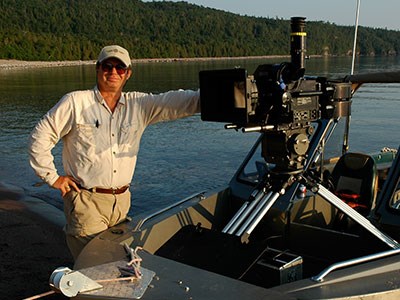David Lickley estimates his movies have made around $100 million over the course of his 20-year career as a filmmaker.
An impressive feat, considering his movies aren't typically screened in conventional movie theatres.
Instead, Lickley belongs to a small group of filmmakers who make large-format IMAX films, primarily destined for museums and science centres around the world.
Lickley's career has brought him to every continent, including Antarctica, where he filmed a large colony of penguins.
After he received a Masters of biology from the University of Alberta, Science North hired Lickley as its director of large format films in 1984, the year the science centre opened.
While Science North did not build its IMAX theatre until 1994, Lickley got his start designing multimedia exhibits and films for the centre's Cavern auditorium.
In 1999 Lickely directed his first IMAX film, “Gold Fever.”
The movie profiled a gold prospector, the Yukon gold rush, and brought viewers to Ghana, where they were introduced to the king of the Ashanti kingdom, who dressed himself in gold from head to toe.
In the years that followed he directed a number of IMAX films including “Jane Goodall's Wild Chimpanzees,” which explored the famous zoologists work with chimpanzees in Africa, and “Mysteries of the Great Lakes,” about the world's largest freshwater bodies.
In 2011 Lickley directed his most successful film to date, a documentary called “Born to be Wild.”
The co-production between Warner Bros. and IMAX documented the people who rescue orphaned elephants and orangutangs in Africa.
The film opened in more than 200 theatres on April 8, 2011, and won a number of awards, including best film at the Giant Screen Cinema Awards and a Genesis award for outstanding feature documentary.
The movie's success marked a turning point for Lickley's career.
“It made me realize it was probably time for me to branch out a bit and give me some flexibility in terms of what projects I could take on,” he said.
In 2012 he parted ways with Science North and started his own production company called Lickley Productions Inc.
Lickley works out of his Sudbury home where he has been able to take on a number of large, and small, film projects.
“I have a small office, I don't have very big overhead, I keep it simple,” he said.
He manages some of the projects himself, while in other cases he works as a freelancer for hire with different production companies.
His latest IMAX film, and his first since he has worked as an independent contractor, was 2014's “Wonders of the Arctic 3D.”
The film screened at Science North over the summer, and showcased the Canadian Arctic with a focus on ongoing exploration and discovery region.
Thanks to advances in technology, Lickley and his crew were able to shoot around half the film with digital cameras.
Until recently, digital film cameras could not approach the quality afforded by the massive 70 mm IMAX film stock.
Lickley said that while IMAX film is still superior for shots of wide vistas, in most other situations the advantages of digital cameras outweigh any visual differences.
“They're way more flexible and lighter,” Lickley said.
A 3D IMAX film camera weighs around 300 lbs., while its digital counterpart comes in at 65 lbs.
The film cameras are also limited to around three minutes of continuous shooting before the camera runs out of film.
With a digital camera, Lickley and his crew can shoot for 30 minutes before they need to change the hard drive.
For nature documentaries digital cameras allow crews to shoot a lot more and not risk missing important shots that could define their films.
Technological strides in moviemaking have also allowed Lickley to move the post-production process to Sudbury.
“We edit these IMAX films on laptops,” he said.
Most film productions in Sudbury leave the post-production to larger centres, like Toronto, but Lickley said his model is the inverse.
He goes off to far-off locales to shoot his movies, but is able to do everything else in Sudbury.
But IMAX films are similar to most other movies shot in the North in that grants from organizations like the Northern Ontario Heritage Fund Corporation still play an important role in getting the films made.
While Lickley's films have done well, most of the revenues go to the exhibitors and movie theatres, and only a small fraction makes its way back to the film producers and investors.
Thirty years after his start at Science North, Lickley said he thinks he still has about 10 years of filmmaking left in him.
“The best privilege I've gotten through this whole thing is that I get access,” he said. “I get access to the people, the places and the stories.”
With that access he can share images most people can't safely witness themselves, and perhaps inspire the next generation of filmmakers or scientists.




